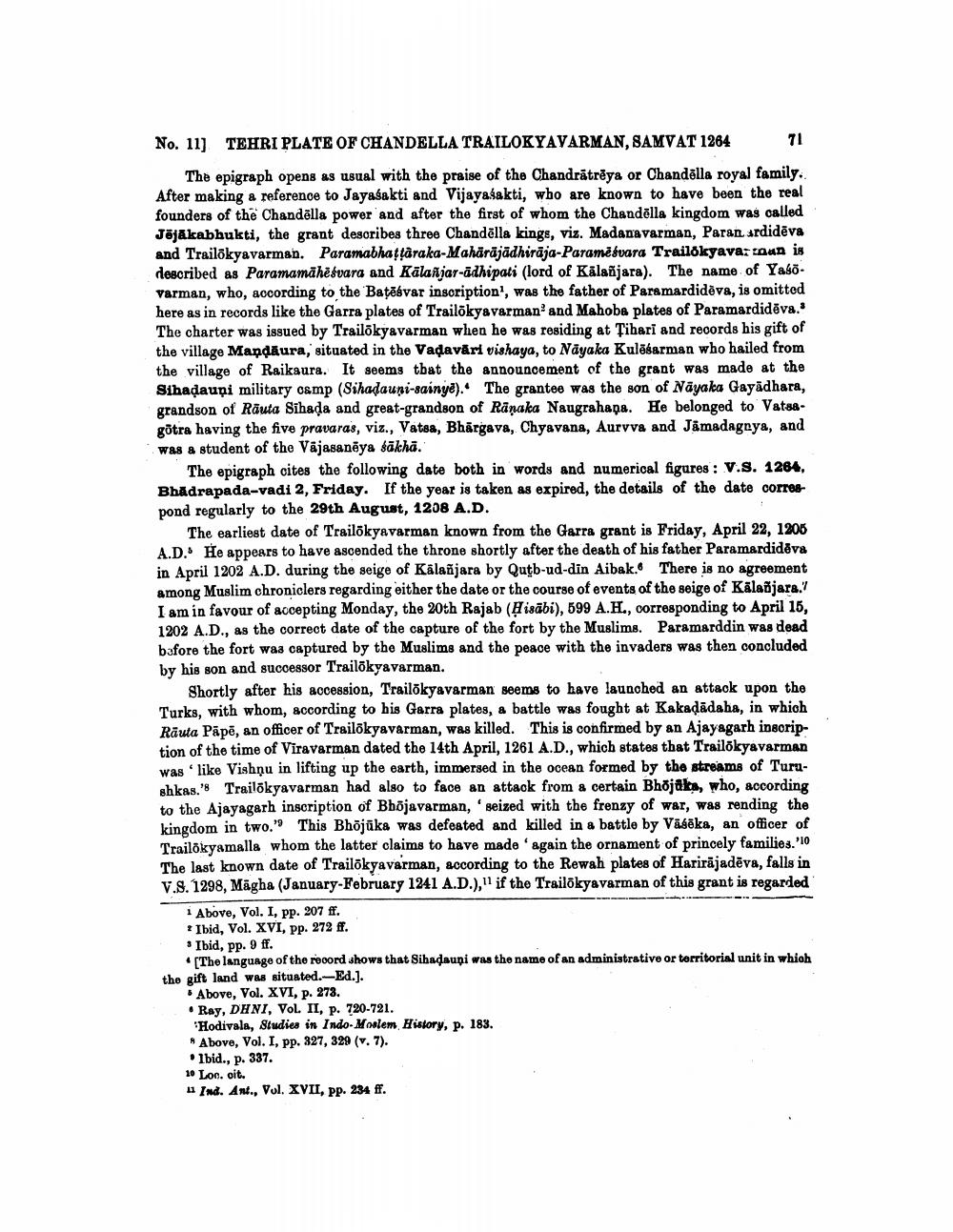________________
No. 11] TEHRI PLATE OF CHANDELLA TRAILOKYAVARMAN, SAMVAT 1264 71
The epigraph opens as usual with the praise of the Chandrātrêya or Chandēlla royal family. After making a reference to Jayasakti and Vijayasakti, who are known to have been the real founders of the Chandēlla power and after the first of whom the Chandēlla kingdom was called Jöjäkabhukti, the grant describes three Chandēlla kings, viz. Madanavarman, Paran ardidēva and Trailokyavarman. Paramabhaffàraka-Mahārājādhiraja-Parameswara Trailokyava: oun is described as Paramamahè svara and Kālañjar-adhipati (lord of Kälañjara). The name of Yaso. Varman, who, according to the Batökvar inscription!, was the father of Paramardidēva, is omitted here as in records like the Garra plates of Trailökyavarman and Mahoba plates of Paramardidēva.' The charter was issued by Trailökyavarman when he was residing at Tihari and records his gift of the village Mapdāura, situated in the Vaqavāri vishaya, to Nayaka Kulēšarman who hailed from the village of Raikaura. It seems that the announcement of the grant was made at the Sibadauni military oamp (Sihadauni-sainyë). The grantee was the son of Nayaka Gayadhara, grandson of Rāuta Sihada and great-grandson of Ranaka Naugrahapa. He belonged to Vatsagötra having the five pravaras, viz., Vatsa, Bhärgava, Chyavana, Aurvva and Jämadagnya, and W&s a student of the Vajasanēya sākha.
The epigraph cites the following date both in words and numerical figures : V.S. 1264, Bhadrapada-vadi 2, Friday. If the year is taken as expired, the details of the date correepond regularly to the 29th August, 1208 A.D.
The earliest date of Trailokyavarman known from the Garra grant is Friday, April 22, 1206 A.D." He appears to have ascended the throne shortly after the death of his father Paramardidēva in April 1202 A.D. during the seige of Kälañjara by Qutb-ud-din Aibak. There is no agreement among Muslim chroniclers regarding either the date or the course of events of the seige of Kälaõjara.' I am in favour of accepting Monday, the 20th Rajab (Pisābi), 599 A.H., corresponding to April 15, 1202 A.D., as the correot date of the capture of the fort by the Muslims. Paramarddin was dead bafore the fort was captured by the Muslims and the peace with the invaders was then concluded by his son and successor Trailokyavarman.
Shortly after his accession, Trailokyavarman seems to have launched an attack upon the Turks, with whom, according to his Garra plates, a battle was fought at Kakadādaha, in which Rauta Pāpē, an officer of Trailökyavarman, was killed. This is confirmed by an Ajayagarh insoription of the time of Viravarman dated the 14th April, 1261 A.D., which states that Trailökyavarman was like Vishnu in lifting up the earth, immersed in the ocean formed by the streams of Turushkas.' Trailökyavarman had also to face an attack from a certain Bhojaka, who, according to the Ajayagarh inscription of Bbõjavarman, 'seized with the frenzy of war, was rending the kingdom in two." This Bhojūka was defeated and killed in a battle by Väsēka, an officer of Trailokyamalla whom the latter claims to have made again the ornament of princely families.'10 The last known date of Trailökyavarman, according to the Rewah plates of Harirājadēva, falls in V.S. 1298, Māgha (January February 1241 A.D.), if the Trailökyavarman of this grant is regarded
1 Above, Vol. I, pp. 207 ff. * Ibid, Vol. XVI, pp. 272 ff.
Ibid, pp. 9 ff.
* [The language of the rooord shows that Sihadauņi was the name of an administrative or territorial unit in which the gift land was situated.-Ed.).
. Above, Vol. XVI, p. 273. • Ray, DHNI, VOL. II, p. 720-721. Hodivala, Studies in Indo-Moslem History, p. 183. Above, Vol. I, pp. 327, 329 (v.7).
Ibid., p. 337. 10 Loc. oit. 11 Ind. Ant., Vol. XVII, pp. 234 ff.




